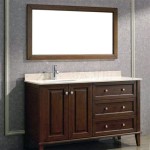Bathroom Sink Elevation: Essential Aspects for a Comfortable and Functional Bathroom
When designing a bathroom, careful consideration should be given to the elevation of the bathroom sink. Proper elevation ensures comfortable use, prevents strain, and enhances the overall functionality of the bathroom space. Here are some essential aspects to keep in mind when determining the ideal bathroom sink elevation:
Standard Height Guidelines
Standard guidelines suggest an average bathroom sink height of 32-34 inches from the finished floor to the rim of the sink. However, it's important to note that this is a general range, and the optimal height may vary depending on individual preferences and needs.
Ergonomic Considerations
Ergonomics plays a crucial role in determining the appropriate sink elevation. The sink should be high enough to allow users to comfortably wash their hands and brush their teeth without hunching over or straining their necks. It should also be low enough to avoid excessive reaching or difficulty for children and wheelchair users.
Height Adjustments for Different Users
The height of the bathroom sink should be adjusted to accommodate different users. Consider the heights of family members or frequent guests who may use the space. If there are significant height variations, installing an adjustable sink with a pull-out spray or a sink with a countertop cutout for wheelchair accessibility can provide a more inclusive and comfortable experience.
Countertop Thickness
The thickness of the bathroom countertop can affect the perceived height of the sink. A thicker countertop will raise the sink higher, while a thinner countertop will lower it. It's important to factor in the desired sink height and countertop thickness when selecting both components.
Vanity Design
The design of the bathroom vanity can influence the sink elevation. A vanity with taller legs or a raised platform will elevate the sink higher than a vanity with shorter legs or a lower profile. Consider the overall vanity design and how it will impact the sink's height.
Aesthetic Considerations
In addition to functional aspects, the elevation of the bathroom sink can also affect the overall aesthetic of the space. A higher sink can create a sense of grandeur and elegance, while a lower sink can lead to a more casual and comfortable atmosphere. Determine the desired aesthetic before finalizing the sink elevation.
By carefully considering these essential aspects, you can ensure that the bathroom sink elevation is optimally suited to your needs and preferences. A properly elevated sink will enhance the comfort and functionality of your bathroom, making it a more enjoyable and welcoming space.

What Is The Standard Height Of A Bathroom Vanity 2024 Guide

What Is The Standard Bathroom Sink Height Counter Top Vanity Sizes Drain

Sink Elevation Free Cads Plumbing Fixtures Wash Basin

What Is The Standard Bathroom Vanity Height Size Guide

Standard Height Of Bathroom Fittings Fantasticeng

Bathroom Sink Front Elevation Block Cad Drawing Details Dwg File Cadbull

What Is The Standard Bathroom Vanity Height Size Guide

Sink Elevation Cad Block Free Cadblocksdwg

Plan Your Bathroom By The Most Suitable Dimensions Guide Engineering Discoveries Vessel Sink Vanity Floor Plans Interior Design

What Is The Standard Height Of A Bathroom Vanity
Related Posts







